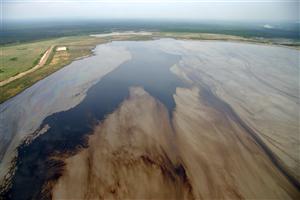Potential Effects of Oil Sands on Aquatic Ecosystems
Oil sands development consumes large amounts of water and energy—currently, two to five barrels of water (natural sources and recycled water) are required for every barrel of oil produced by mining—and produces byproducts such as contaminated tailings. The industrial processes used, and the large scale of oil sands development, can result in negative impacts on the aquatic environment if deliberate action is not taken to protect these ecosystems. Some of the potential impacts on aquatic ecosystems are described below.
To view potential linkages between oil sands activities and aquatic resources, see the impact pathways interactive feature.
Changes to hydrology and aquatic habitat
Oil sands projects can affect the natural hydrology of streams, rivers, and lakes through the following activities:
- Site preparation, which can include site clearing, removal of the overburden, removing or diverting streams, draining wetlands, and altering natural drainage patterns;
- Extraction of groundwater and draw-down of aquifers linked to surface waterbodies; and
- Removal of water from nearby rivers.
Removal of natural soils and vegetation can have important impacts on stream hydrology (see Forestry), while redirection or removal of streams can stress or eliminate aquatic organisms, including fish. In some cases, oil sands operators can “transplant” fish from streams about to be impacted to a different site, while in other cases, the “no net loss” policy requires the creation of new habitat (or enhancement of existing habitat) to compensate for aquatic habitat lost due to project construction and operation.
The physical characteristics, water quality, and productive capacity of river ecosystems are dependent, in part, on maintaining a minimum flow in the river, known as the in-stream flow needs (IFN) (Schindler et al. 2007). In the Athabasca River, successful feeding, migration, rearing and overwintering of various fish species depend on sufficient flows. The perched lakes, wetlands, and waterways of the Athabasca River delta also are highly sensitive to small changes in the level of the Athabasca River (Schindler et al.). Oil sands mining is currently the largest consumer of water from the Athabasca River basin, with approximately 2% of the average annual water flow in the Athabasca River allocated to oil sands projects (AENV 2007). Withdrawal of water during natural low-flow conditions in the river is of concern due to the potential for water levels to drop below the in-stream flow needs.
Potential impacts from withdrawal of water from the Athabasca River have been addressed in Alberta’s “Athabasca River Water Management Framework” (AENV 2007), which was designed to protect the ecological integrity of the Athabasca River during oil sands development by setting maximum withdrawals under various natural flow conditions. Phase 1 was implemented on July 1, 2007, and requires operators to reduce water withdrawals during environmentally sensitive periods. Phase 2 will build on Phase 1 and will develop a long-term strategy based on additional data and considerations.
Changes to water quality
Impacts on water quality can result from the discharge of waters drained from muskeg and the overburden (during site preparation) to natural aquatic systems. The input of these waters—rich in organic matter—can lead to changes in dissolved oxygen levels and changes in stream temperature, both of which can have negative impacts on fish and other aquatic organisms. Concentrations of sediment can also increase if higher discharge resulting from these or other input waters erodes or suspends stream sediments. Other impacts on water quality could result from leaks, seepage, or spills of mine-impacted waters or chemicals used on site, or deposition of air-borne particulates into aquatic ecosystems (RAMP 2005).
Acidification of regional waterbodies
Emissions of sulphur and nitrous oxides from oil sands projects can lead to acidification of regional lakes and waterbodies when these acid-forming substances are deposited in waterbodies or on soils or the snowpack. Acidification can have short-term toxic effects on aquatic animals and vegetation, and can have long-term effects through changes to the aquatic pH and, ultimately, the health of the ecosystem. Emissions of acidifying substances can be minimized through plant design and use of appropriate technologies.
Impacts of tailings
Tailings are a mixture of sand, silt, clay, water, residual bitumen and other hydrocarbons, salts, and trace metals left over from the oil sands mining extraction process (Government of Alberta 2008a). Tailings are discharged into large settling basins known as tailings ponds, where larger particles (e.g., sand) settle quickly to the bottom, leaving a suspension of fine solids and associated chemical residues. Tailings ponds water can be acutely toxic and hence, the water is stored rather than discharged into a receiving environment such as the Athabasca River. Other concerns related to tailings ponds include seepage of contaminated waters into nearby aquatic ecosystems and the long-term viability of the huge tailings ponds, currently covering more than 130 km2 (Government of Alberta 2008a), as a component of the regional landscape.
Because the fine solids in suspension take years to settle, reclamation of tailings requires long-term storage and treatment. Currently, two proposed options for reclamation include consolidated tailings technology and capping with water in end pit lakes. These lakes are proposed to become part of the hydrologic network in reclaimed areas, and may provide new aquatic habitat. However, some uncertainty regarding the quality of water in these lakes and the suitability of these lakes as aquatic habitat remains.









